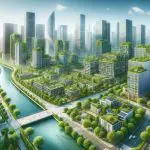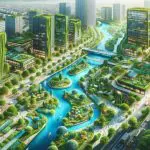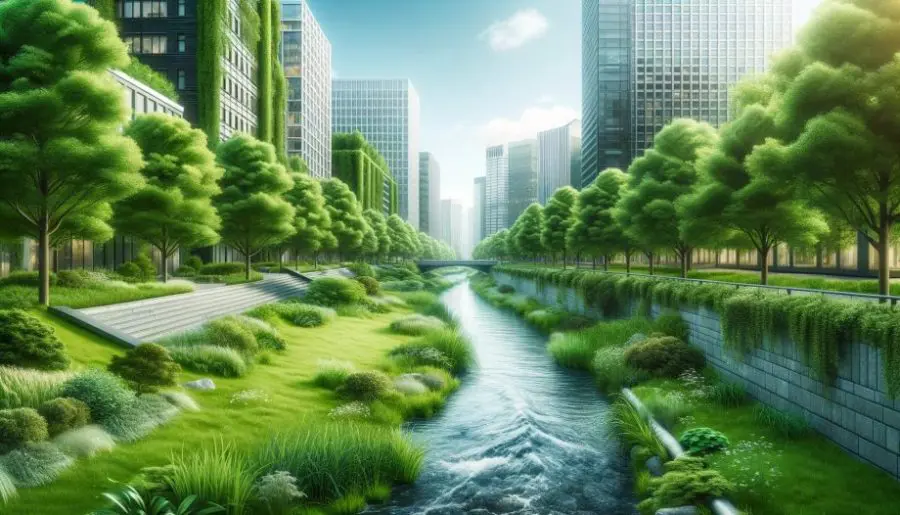
Explore the benefits of green infrastructure: a sustainable solution enhancing urban living, improving the environment, and boosting communities.
Benefits of Green Infrastructure Key Takeaways:
- The benefits of green infrastructure include improved air and water quality, enhanced urban biodiversity, and effective stormwater management.
- These eco-friendly solutions also boost community well-being, increase property values, and create new job opportunities, making cities more sustainable and livable.
Welcome to the world of sustainable urban development, where the benefits of green infrastructure are reshaping our cities!
From lush green roofs to vibrant rain gardens, discover how these innovative solutions not only beautify our urban landscapes but also bring a multitude of environmental, social, and economic advantages.
Let’s dive into this green journey together!
Green Infrastructure in a Nutshell
Green infrastructure (GI) encompasses a variety of elements like green roofs, rain gardens, and permeable pavements, which offer numerous benefits to urban and natural environments.
These include improved air quality, enhanced biodiversity, and the mitigation of the urban heat island effect.
Economic advantages include increased property values and reduced maintenance costs, while social benefits extend to improved public health and quality of life.
However, it’s important to note that there can be challenges, such as initial implementation costs and maintenance requirements.
Join us as we dig deeper into green infrastructure.
What is Green Infrastructure?
Green infrastructure (GI) represents a transformative approach to urban planning and environmental management.
By integrating natural elements into manmade landscapes, it offers a sustainable solution to urban challenges.
This concept reshapes our interaction with the urban environment, prioritizing ecological harmony and resilience.
Definition and Components
At its core, green infrastructure refers to a network of natural and semi-natural spaces, ranging from street trees and parks to green roofs and rain gardens.
These components work collectively to provide ecosystem services, such as air and water filtration, habitat for wildlife, and recreational spaces for humans.
The versatility of GI is evident in its many forms:
- Green Roofs: Rooftop vegetation that provides insulation, reduces stormwater runoff and supports biodiversity.
- Rain Gardens: Shallow depressions that capture rainwater and allow it to soak into the ground, reducing stormwater runoff and pollution.
- Permeable Pavements: Surfaces that allow water to pass through, replenishing groundwater and reducing surface runoff.
- Urban Trees and Parks: Provide shade, improve air quality, and offer recreational spaces.
- Wetlands and Natural Water Bodies: Act as natural water filters and flood protectors.
Comparison with Gray Infrastructure
Traditionally, cities have relied on ‘gray infrastructure’, systems made of concrete and steel, designed for single purposes like transportation or stormwater management.
However, this approach often overlooks the multifunctional benefits that natural systems offer.
In contrast, green infrastructure integrates living, and natural elements into the urban fabric, offering a more holistic approach to urban development.
- Sustainability: Unlike gray infrastructure, GI harnesses natural processes, making it more sustainable and cost-effective in the long run.
- Flexibility and Resilience: GI adapts to environmental changes, providing resilience against climate-related challenges, unlike the more rigid gray infrastructure.
- Multi-functionality: While gray infrastructure often serves a single purpose, GI provides multiple benefits such as enhancing biodiversity, improving public health, and beautifying urban spaces.
In conclusion, green infrastructure presents an innovative, multifaceted approach to urban development, addressing environmental, social, and economic challenges more effectively than traditional gray infrastructure.
It signifies a shift towards a more sustainable, resilient, and integrated urban planning model.
Benefits of Green Infrastructure

Green infrastructure is more than just an aesthetic enhancement.
It’s a critical component for sustainable urban living, intertwining nature’s resilience with urban development.
This approach offers a plethora of benefits, addressing environmental, social, and economic aspects of city life.
Brief Overview of Key Benefits
- Environmental Benefits: Green infrastructure plays a vital role in improving air quality, reducing urban heat island effects, and enhancing biodiversity. It also contributes to better stormwater management, mitigating the impacts of heavy rainfall through natural absorption and filtration processes.
- Social Benefits: These natural spaces offer recreational opportunities, improving mental and physical health. They foster community interaction and provide serene spaces in otherwise bustling urban settings, contributing significantly to the overall quality of life.
- Economic Benefits: GI can lead to cost savings in urban management. It reduces the need for expensive stormwater infrastructure, lowers energy costs through natural cooling, and can increase property values. The maintenance and development of GI also create job opportunities in various sectors, including landscaping and urban planning.
Benefits of Green Infrastructure
| Benefit Type | Examples of Benefits |
|---|---|
| Environmental | – Air quality improvement- Biodiversity enhancement- Stormwater management |
| Social | – Improved public health- Community engagement and recreation |
| Economic | – Increased property values- Job creation in green sectors |
In summary, green infrastructure presents a comprehensive solution, enhancing urban environments while addressing key sustainability challenges.
How Does Green Infrastructure Benefit the Environment?
Green infrastructure (GI) serves as a vital tool in our quest for environmental sustainability.
By integrating natural elements into urban landscapes, GI provides a unique synergy between nature and the built environment, fostering a healthier and more sustainable ecosystem.
Environmental Impact and Sustainability
- Stormwater Management: GI significantly reduces stormwater runoff, a major cause of urban flooding and water pollution. Natural elements like rain gardens, green roofs, and permeable pavements absorb and filter rainwater, reducing the load on storm drains and mitigating flood risks.
- Air Quality Improvement: Urban vegetation plays a crucial role in filtering pollutants and particulates from the air. Trees and plants absorb harmful gases like carbon dioxide, releasing oxygen and improving overall air quality. This process is essential in combating the urban heat island effect, where built-up areas are significantly warmer than surrounding rural areas.
- Biodiversity and Habitat Creation: By incorporating natural landscapes into urban areas, GI provides habitats for a wide range of wildlife. This biodiversity is crucial for maintaining healthy ecosystems and supports natural processes such as pollination and pest control.
- Climate Change Mitigation: GI contributes to carbon sequestration, the process of capturing and storing atmospheric carbon dioxide. This is a key factor in mitigating the effects of climate change. Furthermore, the use of green spaces can help regulate local climates, making urban areas more resilient to extreme weather conditions.
- Water Quality Enhancement: Green infrastructure helps in filtering pollutants from runoff water before it reaches water bodies. This natural filtration process is essential for maintaining the quality of rivers, lakes, and groundwater, ensuring a safer and cleaner water supply.
- Energy Conservation: Strategic placement of green spaces can reduce energy consumption in buildings. Trees and vegetative cover provide natural cooling, reducing the need for air conditioning in warmer months.
In conclusion, green infrastructure offers a multifaceted approach to environmental sustainability.
Its ability to blend ecological functions with urban development makes it a key component in creating resilient and environmentally friendly urban spaces.
What is Green Infrastructure Used For?
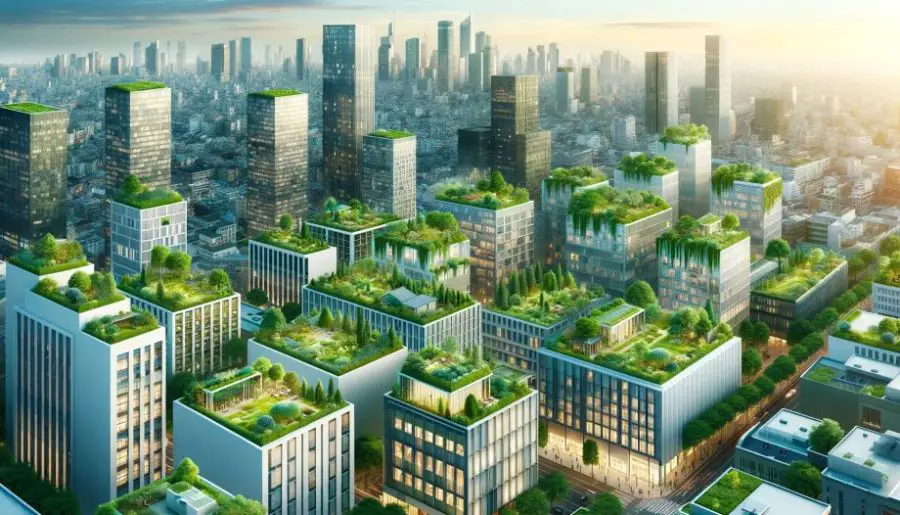
Green infrastructure is not just a decorative feature; it’s a functional asset in both urban and rural landscapes.
This approach to environmental design serves multiple purposes, addressing contemporary challenges in sustainable and effective ways.
Practical Applications in Urban and Rural Settings
- Urban Heat Island Mitigation: In urban areas, GI-like tree canopies and green roofs provide shade, reducing temperatures in densely built environments. This is crucial for mitigating the urban heat island effect, where concrete and asphalt trap heat, making cities significantly warmer than their rural surroundings.
- Enhanced Water Management: GI plays a pivotal role in managing stormwater. Systems like rain gardens, bioswales, and permeable pavements absorb and filter rainwater, reducing the burden on sewer systems and mitigating flood risks. In rural areas, similar techniques help in managing runoff and preserving water quality in natural water bodies.
- Air Quality Improvement: Both in urban and rural settings, plants in GI systems improve air quality by filtering pollutants and producing oxygen. This is especially important in cities, where air pollution from vehicles and industrial activities is a major concern.
- Biodiversity Conservation: By incorporating natural habitats into urban settings, GI supports biodiversity. It provides habitats for various species, contributing to ecological balance. In rural areas, it helps in preserving natural ecosystems and the species that depend on them.
- Recreational Spaces: Green infrastructure creates recreational and communal spaces such as parks and community gardens. These areas are vital for social interaction, physical activities, and mental well-being, contributing to the overall quality of life in both urban and rural settings.
- Economic Development: In urban areas, GI can boost local economies by increasing property values and attracting tourism. In rural areas, it can support sustainable agricultural practices and eco-tourism.
- Climate Resilience: Both urban and rural areas benefit from the climate resilience provided by GI. It helps in adapting to climate change impacts by providing natural buffers against extreme weather events like floods and heatwaves.
In summary, green infrastructure serves a multitude of purposes, from environmental protection to social and economic development, making it a versatile tool in both urban and rural planning strategies.
Examples of Green Infrastructure
Green Infrastructure (GI) encompasses a variety of innovative and sustainable solutions across the globe.
These solutions not only address environmental issues but also enhance the quality of urban life.
This section explores diverse examples of green infrastructure worldwide, with a special focus on rain gardens, green roofs, and permeable pavements.
Diverse Examples Worldwide
- Rain Gardens:
- United States: In Seattle, rain gardens are part of the city’s plan to manage stormwater. These gardens are designed to absorb rainwater runoff from roofs, driveways, and streets, filtering pollutants and reducing the impact on the city’s drainage system.
- United Kingdom: London has implemented rain gardens in various locations, including schools and parks, as part of its sustainable urban drainage systems.
- Green Roofs:
- Germany: Stuttgart, known as the ‘green roof city’, has been a pioneer in green roof implementation, with policies in place since the 1980s. These roofs provide insulation, reduce urban heat, and support biodiversity.
- Canada: Toronto has a bylaw requiring certain new buildings to include green roofs, contributing to the city’s efforts in improving air quality and reducing heat islands.
- Permeable Pavements:
- China: The Sponge City initiative in cities like Shanghai uses permeable pavements extensively to absorb rainwater, preventing flooding and recharging groundwater.
- Australia: Melbourne’s urban renewal projects include permeable paving, which helps manage stormwater runoff, reducing the strain on the city’s drainage systems.
Focus on Rain Gardens, Green Roofs, Permeable Pavement
- Rain Gardens: Rain gardens are effective in capturing and filtering runoff water, helping to reduce pollution entering watercourses. They are versatile and can be incorporated into various urban landscapes, from residential areas to public parks.
- Green Roofs: Green roofs serve multiple functions: they provide insulation, create habitats for wildlife, and help manage rainwater. They are particularly beneficial in dense urban areas where green space is limited.
- Permeable Pavements: Permeable pavements are a solution to urban waterlogging and flood prevention. They allow water to percolate through the ground, reducing surface runoff and recharging aquifers.
These examples illustrate the adaptability and effectiveness of green infrastructure in different environmental and urban contexts.
They highlight how cities worldwide are embracing GI as a tool for sustainable urban development, offering solutions that are both practical and environmentally friendly.
Examples of Green Infrastructure in Cities
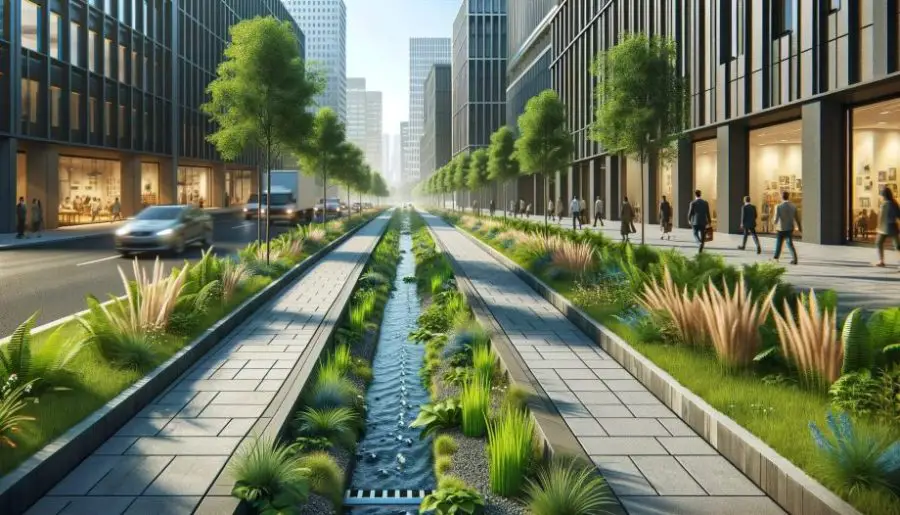 Urban landscapes worldwide are increasingly turning to green infrastructure (GI) as a sustainable solution to environmental challenges.
Urban landscapes worldwide are increasingly turning to green infrastructure (GI) as a sustainable solution to environmental challenges.
From sprawling metropolises to smaller cities, innovative GI projects are making a significant impact.
This section explores various urban case studies showcasing the effectiveness and diversity of GI in city settings.
Urban Case Studies

- New York City, USA: High Line Park
- The High Line is a renowned example of GI, transforming an abandoned railway line into an elevated urban park. This project not only provides green space but also promotes biodiversity and offers recreational opportunities to residents and visitors alike.
- Singapore: Gardens by the Bay
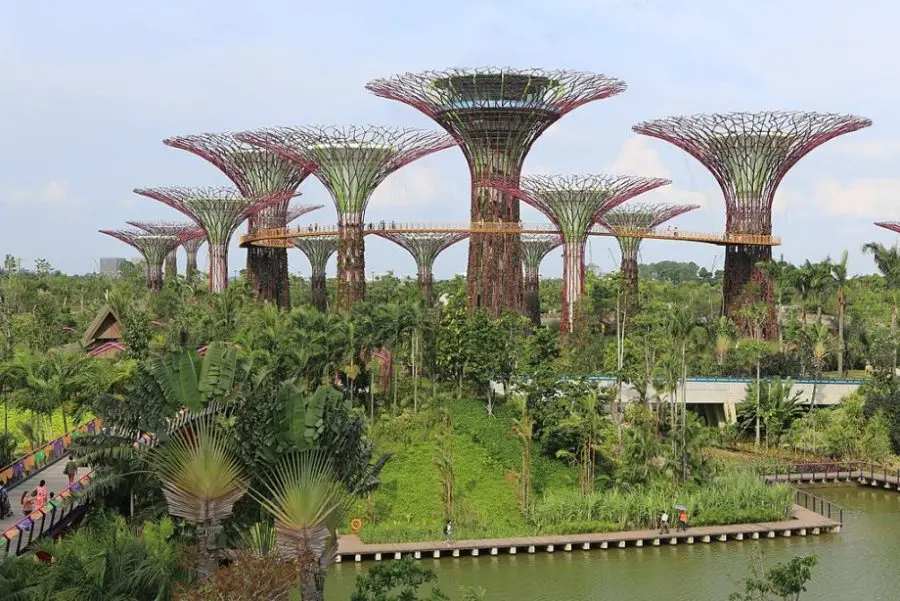
-
- Singapore’s commitment to GI is exemplified in Gardens by the Bay, a futuristic park featuring large artificial trees that function as vertical gardens. This project highlights the city’s innovative approach to incorporating green spaces in urban planning.
- Copenhagen, Denmark: Green Roofs
- Copenhagen mandates green roofs on all new buildings with roof slopes of less than 30 degrees. This initiative aids in stormwater management, reduces urban heat island effects, and provides habitats for wildlife.
- Portland, Oregon, USA: Green Streets Program
- Portland’s Green Streets Program converts traditional street designs into green spaces, incorporating stormwater management facilities like bioswales and rain gardens. This program helps manage runoff, improve water quality, and enhance urban aesthetics.
- Melbourne, Australia: Urban Forest Strategy
- Melbourne’s Urban Forest Strategy aims to increase tree cover to combat the urban heat island effect and enhance biodiversity. This strategic approach includes planting thousands of trees and increasing green spaces across the city.
- Curitiba, Brazil: Integrated Green Infrastructure
- Known for its innovative urban planning, Curitiba integrates GI into various aspects of its design, including parks that serve as floodwater reservoirs and extensive green spaces for public use.
- Amsterdam, Netherlands: Climate Adaptive Green Roofs
- Amsterdam encourages the installation of green roofs, particularly those that can store rainwater and release it slowly. These roofs play a crucial role in climate adaptation strategies for the city.
These examples demonstrate how cities worldwide are utilizing green infrastructure to address environmental issues while enhancing urban living.
They reflect a growing recognition of the importance of integrating natural elements into urban development for a sustainable and resilient future.
Green Stormwater Infrastructure Examples
Green stormwater infrastructure (GSI) is a key component in sustainable urban planning, providing innovative solutions for managing rainwater in a way that mimics natural processes.
These systems play a crucial role in reducing runoff, improving water quality, and enhancing urban landscapes.
Effective Solutions for Stormwater Management
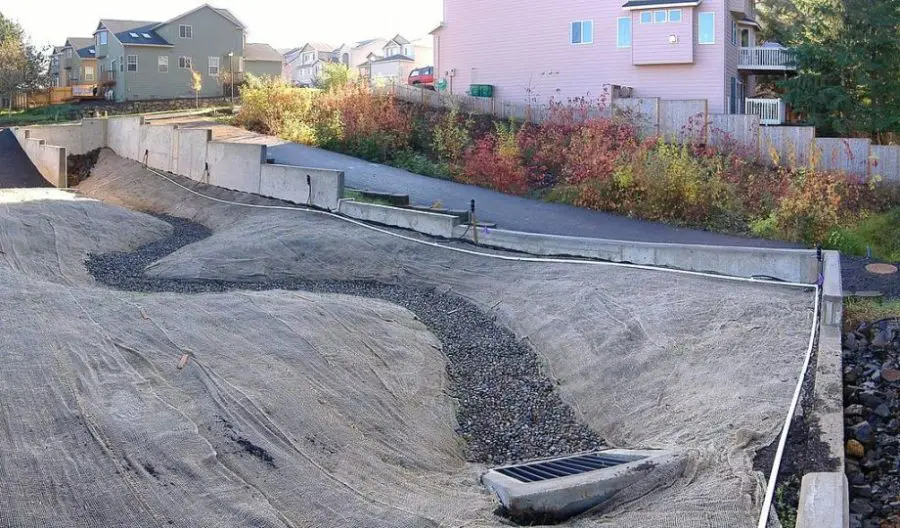
- Bioswales:
- Location: New York City, USA
- Description: NYC has implemented bioswales, vegetated, shallow ditches designed to collect and absorb runoff from streets. They not only filter pollutants but also add greenery to the urban environment.
- Rain Gardens:
- Location: Seattle, USA
- Description: In residential areas of Seattle, rain gardens are used to manage runoff from roofs and driveways. These gardens slow down the flow of water, allowing it to naturally infiltrate into the ground.
- Permeable Pavements:
- Location: Chicago, USA
- Description: Chicago’s Green Alley program uses permeable pavements in alleyways to allow rainwater to seep through the ground, reducing flooding and recharging groundwater.
- Green Roofs:
- Location: Toronto, Canada
- Description: Toronto’s bylaw for green roofs on new large buildings helps to absorb rainwater, thus reducing the load on the city’s sewer systems during heavy rains.
- Constructed Wetlands:
- Location: Charlotte, North Carolina, USA
- Description: Constructed wetlands in Charlotte mimic natural wetlands, treating stormwater runoff through biological and physical processes, and improving water quality before it reaches streams.
- Tree Trenches:
- Location: Philadelphia, USA
- Description: Philadelphia employs tree trenches, which are systems where trees are planted in a trench filled with soil and gravel, allowing stormwater to be absorbed and used by the trees, reducing runoff, and improving air quality.
- Stormwater Ponds:
- Location: Minneapolis, USA
- Description: Stormwater ponds are used in Minneapolis to temporarily hold runoff, allowing pollutants to settle before the water is released into waterways.
- Rain Barrels and Cisterns:
- Location: Portland, Oregon, USA
- Description: Rain barrels and cisterns are used by residents to collect rainwater from roofs, which can then be used for gardening, reducing the demand for the municipal water supply.
These examples illustrate the diverse and effective ways cities are utilizing green stormwater infrastructure to address urban runoff challenges, showcasing their commitment to sustainable and resilient urban development.
Disadvantages of Green Infrastructure
While green infrastructure (GI) offers numerous benefits, it’s important to acknowledge its challenges and potential drawbacks.
Understanding these limitations is crucial for effective planning and implementation, ensuring that GI projects are sustainable and beneficial in the long term.
Challenges and Potential Drawbacks
- Maintenance Requirements:
- GI systems, like green roofs and rain gardens, require regular maintenance to function effectively. This can include tasks like weeding, replanting, and structural repairs, which can be more demanding and costly compared to traditional gray infrastructure.
- Initial Costs:
- The upfront cost for installing GI, such as permeable pavement or green roofs, can be higher than conventional options. This can be a barrier to widespread adoption, especially in areas with limited budgets.
- Space Requirements:
- In densely populated urban areas, finding adequate space for GI elements like large parks or bioswales can be challenging. This limitation can restrict the scope and scale of GI projects.
- Pest and Wildlife Issues:
- Certain types of GI, such as vacant land or poorly maintained spaces, can attract pests and wildlife, leading to potential health and safety concerns.
- Performance Variability:
- The effectiveness of GI can vary based on local climate, soil type, and other environmental factors. This can make it difficult to predict and guarantee performance outcomes consistently.
- Public Perception and Acceptance:
- There can be a lack of public awareness or understanding of the benefits of GI, leading to resistance or apathy towards such projects. Educating communities and stakeholders is crucial for gaining support.
- Integration with Existing Infrastructure:
- Integrating GI with existing urban infrastructure can be complex and costly, especially in older cities with established systems and limited flexibility for modification.
- Limited Effectiveness in Extreme Conditions:
- In extreme weather events, such as heavy storms or prolonged droughts, the capacity of GI to manage environmental challenges may be limited compared to more robust gray infrastructure.
Understanding these challenges is essential for the successful integration of green infrastructure into urban planning.
It requires a balanced approach, combining GI with traditional infrastructure and considering local contexts to optimize environmental, social, and economic benefits.
Economic Benefits of Green Infrastructure
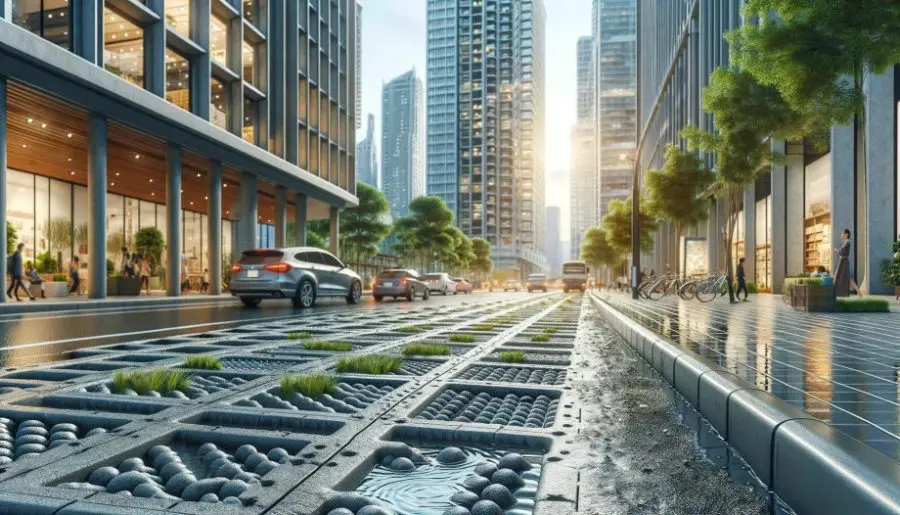
Green Infrastructure (GI) is not just environmentally advantageous; it also brings significant economic benefits.
From cost savings to enhancing property values and job creation, GI is an investment in sustainable urban development with a tangible financial impact.
Cost-effectiveness
GI can be more cost-effective than traditional gray infrastructure in the long term.
- For instance, using natural systems for stormwater management often requires lower capital investment and maintenance costs compared to conventional drainage systems.
- Cities like Philadelphia and New York have adopted GI practices, finding them more economical for managing stormwater than upgrading old sewer systems.
Property Value Increase
The presence of GI, such as well-maintained parks, tree-lined streets, and green roofs, can significantly increase property values.
- For example, studies have shown that properties close to green spaces or with green features can command higher prices.
- This increase in property value benefits both homeowners and local governments through increased tax revenues.
Job Creation
GI projects create jobs in various sectors including landscaping, urban planning, and environmental management.
- The design, installation, and maintenance of GI elements like rain gardens, green roofs, and permeable pavements require skilled labor, contributing to job creation and economic growth.
- Furthermore, these projects can stimulate local economies by attracting tourists and increasing spending in nearby businesses.
Economic Benefits of Green Infrastructure
| Economic Aspect | Description |
|---|---|
| Cost Savings | – Lower stormwater management costs- Energy conservation |
| Property Value | – Increased value of properties near GI elements |
| Job Creation | – Employment opportunities in landscaping, urban planning |
In summary, the economic benefits of green infrastructure extend beyond its environmental impact, offering cost-effective solutions, enhancing property values, and creating employment opportunities, making it a valuable component of urban development strategies.
Environmental Benefits of Green Infrastructure
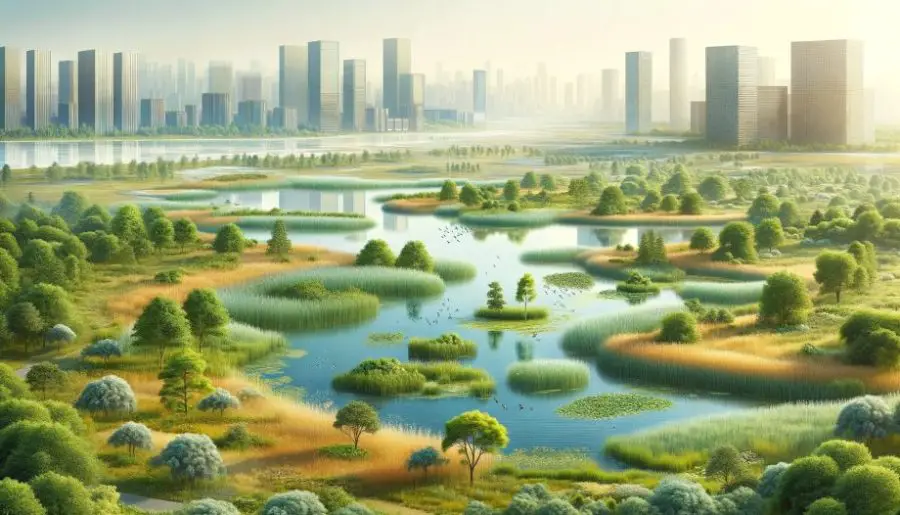
Green infrastructure (GI) is a cornerstone in promoting environmental sustainability.
It offers a range of ecosystem services, supports biodiversity, and plays a crucial role in climate regulation, demonstrating its significant impact on the health of our planet.
Ecosystem Services
GI provides essential ecosystem services such as purifying air and water, reducing erosion, and replenishing groundwater.
- For example, urban trees and vegetative cover improve air quality by absorbing pollutants and producing oxygen.
- Wetlands and permeable surfaces filter pollutants from stormwater, enhancing water quality and protecting aquatic ecosystems.
Biodiversity
By integrating natural habitats into urban areas, GI supports a diverse range of flora and fauna.
This is crucial for maintaining ecological balance and promoting biodiversity.
Green roofs, urban gardens, and parks create habitats for birds, insects, and other wildlife, contributing to urban biodiversity and supporting important ecological functions like pollination and seed dispersal.
Climate Regulation
GI contributes significantly to climate regulation. It helps in mitigating the urban heat island effect through natural cooling provided by trees and vegetation.
- Additionally, GI elements like forests and green spaces are effective in carbon sequestration, absorbing carbon dioxide from the atmosphere and helping to combat climate change.
- This natural absorption of greenhouse gases is vital for reducing global warming and promoting a healthier environment.
Environmental Benefits of Green Infrastructure
| Environmental Aspect | Description |
|---|---|
| Air Quality | – Pollution absorption- Oxygen production |
| Water Quality | – Natural filtration of pollutants- Groundwater replenishment |
| Climate Regulation | – Carbon sequestration- Urban heat island mitigation |
| Biodiversity | – Habitat creation for wildlife- Ecological balance support |
In conclusion, the environmental benefits of green infrastructure are wide-ranging and impactful.
By harnessing the power of nature, GI helps in creating more resilient and sustainable ecosystems, crucial for the well-being of our planet and future generations.
Social Benefits of Green Infrastructure
Green infrastructure (GI) not only transforms urban environments but also significantly enhances social well-being.
It creates spaces that foster community engagement, improve health, and offer recreational opportunities, contributing to the overall quality of life in urban areas.
Community Well-being
GI provides communal spaces such as parks, community gardens, and green streets, which are vital for social interaction and community building.
These spaces offer venues for cultural and social events, fostering a sense of community and belonging.
For example, community gardens not only provide green spaces but also serve as hubs for community engagement and education.
Health Benefits
The presence of green spaces in urban areas has been linked to various health benefits.
These include reduced stress, improved mental health, and lower rates of obesity and related health problems.
Accessible green areas encourage physical activities like walking and jogging, contributing to the overall physical well-being of residents.
Additionally, improved air quality resulting from GI can lead to better respiratory health.
Recreational Spaces
GI offers recreational opportunities within urban environments. Parks, greenways, and waterfronts provide spaces for leisure activities such as walking, cycling, and sports.
These recreational spaces are crucial for improving the quality of life, especially in densely populated urban areas.
They offer a respite from the urban hustle, allowing residents to connect with nature and engage in physical activities.
In summary, the social benefits of green infrastructure are extensive, enhancing community well-being, improving health outcomes, and providing valuable recreational spaces.
These benefits highlight the importance of integrating GI into urban planning to create more livable, healthy, and cohesive communities.
Benefits of Green Infrastructure FAQs
Green infrastructure (GI) is a growing field with increasing interest and application in urban planning.
This FAQ section addresses common questions about GI, providing clear and concise answers to help readers understand its importance, functions, and benefits.
Q: What are the benefits of sustainable infrastructure?
A: Sustainable infrastructure, including GI, offers environmental benefits like improved air and water quality, social benefits such as enhanced community spaces and health, and economic advantages including increased property values and job creation.
Q: What are the values of green infrastructure?
A: GI values include enhancing biodiversity, mitigating climate change, providing ecosystem services, improving mental and physical health, and fostering community engagement and resilience.
Q: What are the economic benefits of green infrastructure and designed landscapes?
A: Economic benefits include cost savings in stormwater management, energy conservation, increased property values, job creation in the green sector, and boosting local economies through increased tourism and recreational opportunities.
Q: What is the main advantage of green infrastructure as compared to grey infrastructure?
A: The main advantage of GI over grey infrastructure is its multifunctionality.
GI provides ecosystem services, enhances urban resilience, and offers social and environmental benefits, whereas grey infrastructure typically serves a single purpose, like transportation or stormwater management.
Q: What are the most important functions of green infrastructure and why?
A: Important functions of GI include stormwater management, improving air and water quality, creating wildlife habitats, and providing recreational spaces.
These functions are crucial for sustainable urban development, enhancing environmental resilience, and improving the quality of life in urban areas.
Q: What are the benefits of blue and green infrastructure?
A: Blue and green infrastructure benefits include improved water management, enhanced biodiversity, recreational opportunities, climate regulation, and urban beautification.
Blue infrastructure specifically focuses on water bodies and wetlands, playing a critical role in ecosystem health and resilience.
Q: What are examples of green infrastructure?
A: Examples include green roofs, rain gardens, permeable pavements, urban tree planting, parks, and bioswales.
These elements are integrated into urban planning to provide environmental, social, and economic benefits.
Q: What is another term for green infrastructure?
A: Another term for GI is living infrastructure. This term emphasizes the integration of living, and natural elements into the built environment for sustainable urban development.
Q: What are the aims of green infrastructure?
A: The aims of GI include improving environmental quality, enhancing urban resilience, promoting sustainability, and providing social and economic benefits through the integration of natural elements into urban landscapes.
Benefits of Green Infrastructure Conclusion
Green infrastructure (GI) represents a vital shift in urban planning and environmental management, intertwining the natural world with urban development.
This holistic approach not only addresses current environmental challenges but also paves the way for a sustainable and resilient future. Read more: Nature-Based Solutions to Climate Change
Summary of Key Points
- Definition and Purpose: GI includes a range of natural and semi-natural systems integrated into urban environments, such as green roofs, rain gardens, and permeable pavements, serving to enhance ecosystem services and urban resilience.
- Environmental Benefits: GI plays a crucial role in improving air and water quality, managing stormwater, supporting biodiversity, and mitigating the impacts of climate change. These benefits are essential for maintaining ecological balance and promoting sustainability.
- Economic Advantages: GI offers significant economic benefits, including cost savings in stormwater management, increased property values, and job creation. These aspects highlight its role not just as an environmental solution, but also as a financially viable investment.
- Social Impacts: The social benefits of GI, such as improved public health, enhanced community well-being, and recreational opportunities, contribute to a higher quality of life in urban areas. Access to green spaces has been linked to better mental and physical health outcomes.
- Challenges and Considerations: While GI offers numerous advantages, it also presents challenges such as maintenance requirements, initial costs, and space constraints. Understanding these limitations is crucial for effective and sustainable GI implementation.
- Global Examples: Cities worldwide are embracing GI to address urban environmental issues, with diverse examples demonstrating its adaptability and effectiveness in different contexts. These range from rain gardens in Seattle to green roofs in Copenhagen, showcasing the global commitment to sustainable urban development.
In conclusion, green infrastructure is a key component of sustainable urban planning, offering a multifaceted approach to environmental, economic, and social challenges.
As cities continue to grow and face new environmental pressures, the integration of GI into urban landscapes will be crucial for creating more resilient, healthy, and livable communities for the future.
Resources Section
For further reading and a comprehensive understanding of Green Infrastructure (GI), the following resources and references are highly recommended:
- What Are the Hidden Co-Benefits of Green Infrastructure? by Climate Columbia University
- This resource provides insights into the various benefits and some lesser-known advantages of green infrastructure.
- Read more
- Global Designing Cities Initiative: Benefits of Green Infrastructure
- An in-depth look into how green infrastructure benefits urban environments, with a focus on street design and community impact.
- Read more
- World Resources Institute: Debunking Myths: 5 Things to Know About Green Infrastructure
- This article addresses common misconceptions about green infrastructure and highlights its multifaceted benefits.
- Read more
- Earth.Org: The Benefits of Green Infrastructure Investments in Urban Planning
- A comprehensive article discussing the social, health, and economic benefits of green infrastructure in urban planning.
- Read more
- Green Infrastructure: Guide to Water Management by Environmental Protection Agency
- An official guide by the EPA, offers detailed information on how green infrastructure contributes to effective water management.
- Read more
- Urban Green: Innovative Parks for Resurgent Cities by Peter Harnik
- A book focusing on the transformation of urban spaces into green, sustainable areas.
- Available on Amazon
These resources provide a wealth of information for anyone interested in learning more about the role, implementation, and impact of green infrastructure in urban settings.




